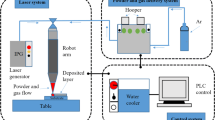Abstract
In laser surface cladding process, the formed clad geometry is directly affected by laser cladding parameters like laser power, scan speed, and powder feed rate. Therefore, finding an optimal parameter setting to increase the process performance is crucial. In the present study, experimental investigation on laser cladding process of AISI 1040 has been performed. Here, numbers of nine experiments were designed and conducted based on L9 orthogonal array design to study effects of mentioned factors on clad height, clad width, and clad depth. Then the principal component analysis (PCA) was integrated with TOPSIS method for multiresponses optimization of laser cladding process. Here, the PCA was used to find appropriate weight factor related to each quality characteristic. Hereafter, the technique for order preference by similarity to ideal solution (TOPSIS) was utilized to find optimal solutions. Confirmatory experiments were carried out to validate optimal results. Results revealed that the laser power has greatest influence on laser cladding quality characteristics. Furthermore, results which were obtained through of confirmatory experiments reveal that the developed method can effectively acquire the optimal combination of laser cladding parameters.
Similar content being viewed by others
References
Deus D (2004) A thermal and mechanical model of laser cladding. Dissertation Abstracts International 65–04 (Section: B); Chapter 1
Price JWH, Ziara-Paradowska A, Joshi S, Finlayson T, Semetay C, Nied H (2008) Comparison of experimental and theoretical residual stresses in welds: the issue of gauge volume. Int J Mech Sci 50(3):513–521
Luo F, Yao JH, Hu XX, Chai GZ (2011) Effect of laser power on the cladding temperature field and the heat affected zone. J Iron Steel Res Int 18(1):73–78
Qi H, Azer M, Singh P (2010) Adaptive tool path deposition method for laser net shape manufacturing and repair of turbine compressor airfoils. Int J Adv Manuf Technol 48(1):121–131
Onwubolu GC, Davim JP, Oliveira C, Cardoso A (2007) Prediction of clad angle in laser cladding by powder using response surface methodology and scatter search. Opt Laser Technol 39(6):1130–1134
Kumar A, Roy S (2009) Effect of three-dimensional melt pool convection on process characteristics during laser cladding. Comput Mater Sci 46(2):495–506
Dubourg L, St-Georges L (2006) Optimization of laser cladding process using Taguchi and EM methods for MMC coating production. J Therm Spray Technol 15(4):790–795
Hofman JT, de Lange DF, Pathiraj B, Meijer J (2011) FEM modeling and experimental verification for dilution control in laser cladding. J Mater Process Technol 211(2):187–196
Long RS, Liu WJ, Xing F, Wang HB (2008) Numerical simulation of thermal behavior during laser metal deposition shaping. Trans Nonferrous Metals Soc China 18(3):691–699
Palumbo G, Pinto S, Tricarico L (2004) Numerical finite element investigation on laser cladding treatment of ring geometries. J Mater Process Technol 155–156:1443–1450
Zhao HY, Zhang HT, Xu CH, Yang XQ (2009) Temperature and stress fields of multi-track laser cladding. Trans Nonferrous Metals Soc. China 19(Suppl. 2):s495–501
Zhu WD, Liu QB, Li HT, Zheng M (2007) A simulation model for the temperature field in bioceramic coating cladded by wide-band laser. Mater Des 28(10):2673–2677
Benyounis KY, Olabi AG (2008) Optimization of different welding processes using statistical and numerical approaches—a reference guide. Adv Eng Softw 39(6):483–496
Benyounis KY, Olabi AG, Hashmi MSJ (2005) Effect of laser welding parameters on the heat input and weld-bead profile. J Mater Process Technol 164–165:978–985
Benyounis KY, Olabi AG, Hashmi MSJ (2005) Optimizing the laser-welded butt joints of medium carbon steel using RSM. J Mater Process Technol 164–165:986–989
Hamad AR, Abboud JH, Shuaeib FM, Benyounis KY (2010) Surface hardening of commercially pure titanium by laser nitriding: response surface analysis. Adv Eng Softw 41(4):674–679
Choudhury IA, Shirley S (2010) Laser cutting of polymeric materials: an experimental investigation. Opt Laser Technol 42:503–508
Dhupal D, Doloi B, Bhattacharyya B (2009) Modeling and optimization on Nd:YAG laser turned micro-grooving of cylindrical ceramic material. Opt Lasers Eng 47:917–925
Kuar AS, Doloi B, Bhattacharyya B (2006) Modeling and analysis of pulsed Nd:YAG laser machining characteristics during micro-drilling of zirconia (ZrO2). Int J Mach Tools Manuf 46:1301–1310
Sun Y, Hao M (2012) Statistical analysis and optimization of process parameters in Ti6Al4V laser cladding using Nd:YAG laser. Opt Lasers Eng 50:985–995
Mondal S, Paul CP, Kukreja LM, Bandyopadhyay PPK (2013) Application of Taguchi-based gray relational analysis for evaluating the optimal laser cladding parameters for AISI1040 steel plane surface. Int J Adv Manuf Technol 66:91–96
Lu HS, Chang CK, Hwang NC, Chung CT (2009) Grey relational analysis coupled with principal component analysis for optimization design of the cutting parameters in high-speed end milling. J Mater Process Technol 209:3808–3817
Sivapirrakasam SP, Mathew J, Surianarayanan M (2011) Multi-attribute decision making for green electrical discharge machining. Expert Syst Appl 38:8370–8374
Author information
Authors and Affiliations
Corresponding author
Rights and permissions
About this article
Cite this article
Marzban, J., Ghaseminejad, P., Ahmadzadeh, M.H. et al. Experimental investigation and statistical optimization of laser surface cladding parameters. Int J Adv Manuf Technol 76, 1163–1172 (2015). https://doi.org/10.1007/s00170-014-6338-x
Received:
Accepted:
Published:
Issue Date:
DOI: https://doi.org/10.1007/s00170-014-6338-x



